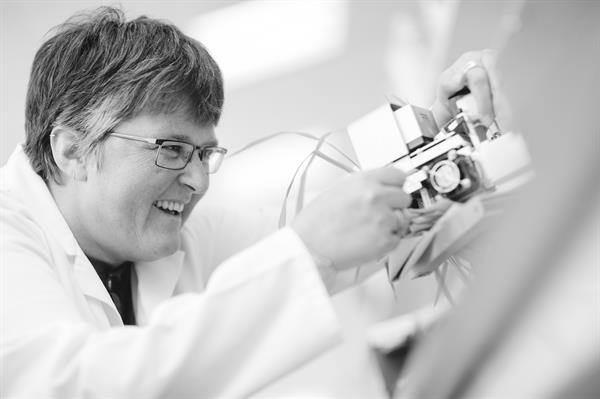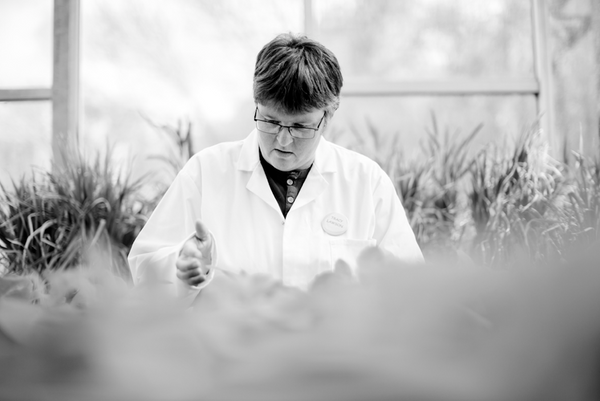In conversation with… Tracy Lawson
Ever since she grew an apple from a pip when she was 10 years old, Tracy Lawson knew she wanted to work with plants. Now Professor of Plant Physiology at the University of Essex, she talks with Caroline Wood about her varied career, how she came to specialise in plant stomata, and her plans as incoming Vice Chair of the SEB to support the next generation of researchers.
“I’ve always been fascinated by plants. As a child, I had my own greenhouse and grew just about everything I could in it—tomatoes, cucumbers, cabbages, cauliflowers, and so on. Even now, after studying plants for over 30 years, I’m still inspired by them every day,” Tracy says. This led naturally to a biology degree from Liverpool John Moore’s University, (choosing “as many plant modules as possible”), and then a PhD with Jonathan Weyers’ group at the University of Dundee. It was here that stomata (the pores on plant leaves that control water and gas exchange) first became a dominant theme within her research. “During my undergraduate degree, I took part in a field course in Majorca which involved taking leaf samples to study using electron microscopy back in the UK. I was absolutely captivated by stomata, particularly the different morphological adaptations to cope with dry conditions, such as being sunken within the leaf to minimise water loss. I accepted my first PhD offer straight away simply because it meant I could study stomata in even greater detail.”
Her doctorate, on the theme ‘Heterogeneity in stomatal characters’, confirmed both her love of plant physiology and lab work. “I was never out of the lab, including evenings and weekends, and the department were always asking me to give the tours on open days because I was so enthusiastic!” she recalls. Nevertheless, Tracy was equally passionate about sharing her work and learning from others at scientific conferences, with the SEB Annual Meeting being a particular highlight each year. “My supervisor, Jonathan Weyers, was the one who encouraged me to join the SEB and the Annual Meeting was the first conference where I gave a talk. Even now, it is the conference that I have attended the most, and I’ve barely missed one since my PhD days,” she says. She was also highly active in the SEB/British Ecological Society special interest group the Plant Environmental Physiology Group (PEPG), and remembers how attending one of their workshops in Italy particularly benefited her career. “Besides introducing me to cutting-edge research techniques, such as chlorophyll fluorescence, the workshop was a brilliant networking opportunity. I met some of the top names in plant physiology, some of whom I have stayed in touch with and even collaborated with on joint research projects,” she says.

After her PhD, various postdoctoral positions saw her working with a wide range of different species and scientific methods, from studying soil microbial activity at the University of Dundee, to developing transgenic tobacco at the Australian National University, Canberra. Particularly memorable was a position at the University of Nottingham working on an EU-level project investigating the potential impacts of climate change on potato yield and quality. “It remains the largest experiment I have ever worked on, with a huge field site involving open top chambers with miles of cabling and piping. It took 3 months just to set it up, and was a real learning curve for me. Up to that point, I was more used to working on the single-leaf level so had to learn a whole new set of skills. In essence, we confirmed that elevated CO2 levels protect from the effects of increased ozone, due to a reduction in stomatal aperture.”
She was originally drawn to the University of Essex by an opportunity to study the role of guard cell chloroplasts in stomatal movements using pioneering high-resolution chlorophyll fluorescence imaging. “Ever since that workshop in Italy, chlorophyll fluorescence was a technique I was really keen to develop further, and Essex was the home of this method,” she explains. The University of Essex eventually became her home also, with Tracy being appointed a permanent Professorship in 2016. Now leading her own lab, stomata are still one of her core research themes. “I have never given them up,” she says. “There is a particularly urgent need to optimise water-use efficiency in plants, because climate change causes the water supply to become problematic in certain regions. Stomata really are the gatekeepers for this, because their kinetics determine the balance between water loss from the plant, and the rate at which it can photosynthesise.”
Despite being happiest when in the lab, Tracy is also committed to applying research in the real world to realise societal benefits. “I’ve always been a very practical person; after all, I grew up on a farm in Northumberland driving tractors and combine harvesters,” she says. “During my undergraduate, I did an industrial placement at Schering Agrochemicals Ltd. in Saffron Walden, testing sprays and pesticides. It gave me a good insight into how science is applied in the real world, and the important role industry plays in this.” Consequently, her current portfolio includes a number of exciting projects looking to apply her research skills to help solve key industrial challenges. This includes investigating whether customised ‘light recipes’ from LEDs could manipulate plant-based signal feedback mechanisms to optimise growth and productivity. “Besides increasing yields, for instance through manipulating light intensity, this would also help reduce energy usage and carbon footprints of growing facilities,” Tracy explains.

Alongside this busy research life, Tracy is dedicated to making the most of her time as the SEB’s new Vice President. This includes using her skills and experiences to support the next cohort of PhD and early-career researchers. “As a PhD student, being part of the SEB was enormously beneficial to me in terms of meeting people and having the opportunity to present my own research. Science has changed so much since then, both in how we do it and in how we communicate it, and we need to make sure we are still delivering these benefits to the next generation of researchers.” She is particularly keen to support women researchers starting their career, recognising that confidence can be an issue. “I think it is often the case that women feel that they need to match every requirement on a job specification or application before they apply, and therefore need more encouragement to put themselves forwards,” she says.
After such a tumultuous time for science during the coronavirus pandemic, Tracy is now, like many of us, eagerly looking forward to being reunited with SEB colleagues and friends at the 2022 SEB Annual Conference in Montpellier, France. “Online meetings have been great for keeping in touch and have even led to some scientific meetings becoming more accessible and inclusive,” she says. “But now I think we are all utterly ‘Zoomed-out’ and I really miss those face-to-face interactions and discussions that you normally have at conferences. I would always come back from the SEB meeting absolutely buzzing with ideas and motivation after a full-on week of science. I can’t wait to experience that again.”
